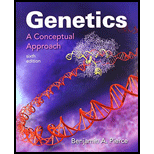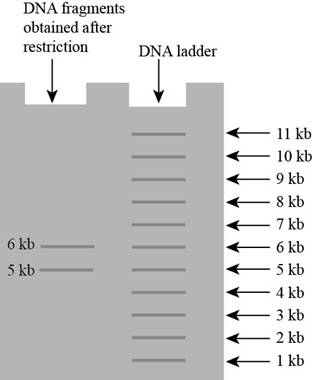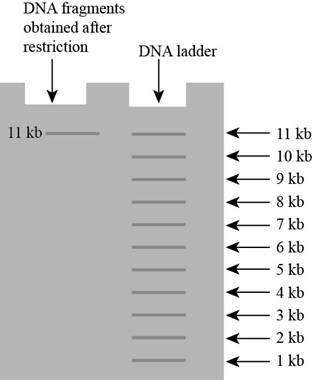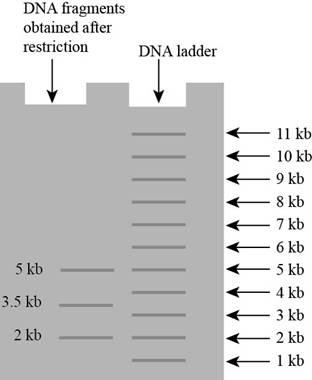
a.
To determine:
The piece of DNA is cut by EcoRI, the resulting fragments are separated by gel electrophoresis, and the gel is stained with ethidium bromide. Draw a picture of the bands that will appear on the gel.
Introduction:
EcoRI is type II restriction enzyme.
a.
Explanation of Solution
Pictorial representation: The following gel shows that DNA fragments are present after the EcoRI has cleaved at

Fig. 1: Gel electrophoresis DNA fragmentation.
After the action of enzyme EcoRI on the DNA, it will produce three fragments of length
b.
To determine:
If a mutation that alters EcoRI site 1 occurs in this piece of DNA, how will the banding pattern on the gel differ from the one that drew in part a?
Introduction:
EcoRI is type II restriction enzyme.
b.
Explanation of Solution
Pictorial representation: The following gel on that DNA fragments only two fragments of length is obtained

Fig 2 Gel fragmentation
Only two fragments will obtained if the EcoRI site 1 is mutated, two fragments are
c.
To determine:
The difference of banding pattern on the gel that drew in part a if mutations that alter EcoRI sites 1 and 2 occur in this piece of DNA.
Introduction:
EcoRI is type II restriction enzyme.
c.
Explanation of Solution
Pictorial representation: The gel electrophoresis after the mutation occurs at both sites.

Fig. 3: Gel electrophoresis result
If mutation occur on the both sites, then there will be no cutting and if there will be no cutting then fragment will remain same.
d.
To determine:
The difference of banding pattern on the gel differ from the one that drew in part a if the 1000 bp of DNA were inserted between the two restriction sites.
Introduction:
EcoRI is type II restriction enzyme.
d.
Explanation of Solution
Pictorial representation: The gel on that DNA fragments only two fragments of length is obtained

Fig 4: Gel fragmentation
Inserting
e.
To determine:
The difference in the banding pattern on the gel differ from the one that drew in part a if 500 bp of DNA between the two restriction sites were deleted.
Introduction:
EcoRI is type II restriction enzyme.
e.
Explanation of Solution
Pictorial representation: The gel on that DNA fragments only three fragments of length are obtained

Fig 5 Gel fragmentation
Deleting
Want to see more full solutions like this?
Chapter 19 Solutions
Genetics: A Conceptual Approach 6E w/ SaplingPlus (Six-Month Access)
 Human Anatomy & Physiology (11th Edition)BiologyISBN:9780134580999Author:Elaine N. Marieb, Katja N. HoehnPublisher:PEARSON
Human Anatomy & Physiology (11th Edition)BiologyISBN:9780134580999Author:Elaine N. Marieb, Katja N. HoehnPublisher:PEARSON Biology 2eBiologyISBN:9781947172517Author:Matthew Douglas, Jung Choi, Mary Ann ClarkPublisher:OpenStax
Biology 2eBiologyISBN:9781947172517Author:Matthew Douglas, Jung Choi, Mary Ann ClarkPublisher:OpenStax Anatomy & PhysiologyBiologyISBN:9781259398629Author:McKinley, Michael P., O'loughlin, Valerie Dean, Bidle, Theresa StouterPublisher:Mcgraw Hill Education,
Anatomy & PhysiologyBiologyISBN:9781259398629Author:McKinley, Michael P., O'loughlin, Valerie Dean, Bidle, Theresa StouterPublisher:Mcgraw Hill Education, Molecular Biology of the Cell (Sixth Edition)BiologyISBN:9780815344322Author:Bruce Alberts, Alexander D. Johnson, Julian Lewis, David Morgan, Martin Raff, Keith Roberts, Peter WalterPublisher:W. W. Norton & Company
Molecular Biology of the Cell (Sixth Edition)BiologyISBN:9780815344322Author:Bruce Alberts, Alexander D. Johnson, Julian Lewis, David Morgan, Martin Raff, Keith Roberts, Peter WalterPublisher:W. W. Norton & Company Laboratory Manual For Human Anatomy & PhysiologyBiologyISBN:9781260159363Author:Martin, Terry R., Prentice-craver, CynthiaPublisher:McGraw-Hill Publishing Co.
Laboratory Manual For Human Anatomy & PhysiologyBiologyISBN:9781260159363Author:Martin, Terry R., Prentice-craver, CynthiaPublisher:McGraw-Hill Publishing Co. Inquiry Into Life (16th Edition)BiologyISBN:9781260231700Author:Sylvia S. Mader, Michael WindelspechtPublisher:McGraw Hill Education
Inquiry Into Life (16th Edition)BiologyISBN:9781260231700Author:Sylvia S. Mader, Michael WindelspechtPublisher:McGraw Hill Education





